Power Distribution Transformer: Revolutionizing Grid Efficiency and Reliability in the Smart Energy Era?
Are you struggling with power grid inefficiencies and reliability issues? You’re not alone. Many utilities face challenges in meeting the demands of our increasingly electrified world.
Power distribution transformers are revolutionizing grid efficiency and reliability in the smart energy era. They incorporate advanced monitoring systems, smart control features, and improved materials to reduce losses, enhance power quality, and support integration of renewable energy sources. These innovations are crucial for creating a more resilient and sustainable power infrastructure.
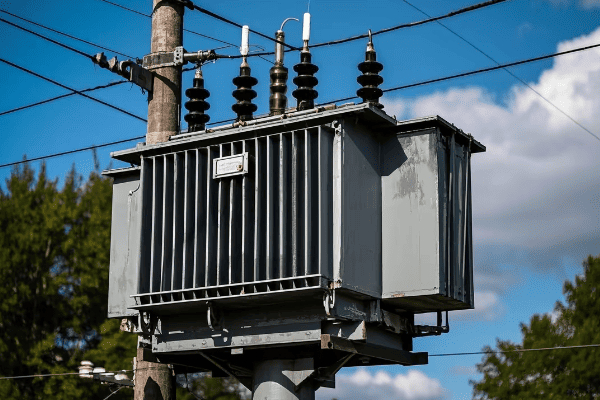
As someone who has spent years working with power distribution systems, I’ve seen firsthand how transformers have evolved to meet the challenges of our changing energy landscape. In this article, I’ll guide you through the latest innovations in power distribution transformers and how they’re shaping the future of our electrical grids.
How Are Smart Technologies Enhancing the Efficiency of Power Distribution Transformers?
Are you wondering how to improve the efficiency of your power distribution network? Smart technologies in transformers might be the solution you’re looking for.
Smart technologies are significantly enhancing power distribution transformer efficiency through real-time monitoring, adaptive voltage regulation, and predictive maintenance capabilities. These features allow for optimal load management, reduced energy losses, and extended transformer lifespan, ultimately leading to more efficient and cost-effective power distribution.
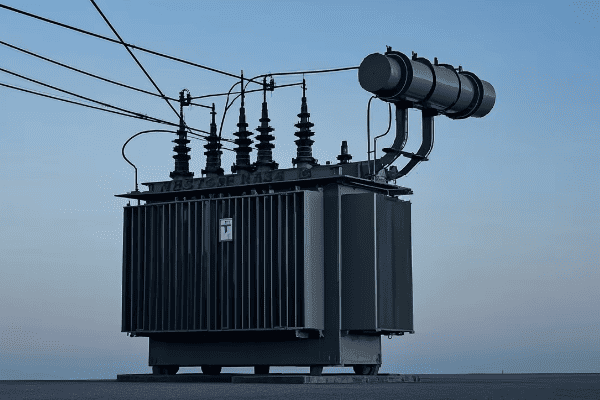
Let’s dive deeper into how smart technologies are revolutionizing transformer efficiency:
Real-Time Monitoring Systems
Smart transformers now come equipped with advanced sensors and monitoring capabilities.
Key Monitoring Features:
- Continuous tracking of load conditions
- Temperature and oil level monitoring
- Power quality analysis in real-time
Adaptive Voltage Regulation
Modern transformers can adjust their output based on grid conditions.
Voltage Regulation Advancements:
- Automatic tap changing for optimal voltage levels
- Dynamic VAR compensation
- Harmonics mitigation for improved power quality
Predictive Maintenance Capabilities
AI and machine learning are changing how we maintain transformers.
Predictive Maintenance Benefits:
- Early detection of potential failures
- Optimized maintenance schedules
- Reduced downtime and extended transformer life
Energy Loss Reduction
Smart technologies help minimize both no-load and load losses.
Loss Reduction Strategies:
- Advanced core materials for lower no-load losses
- Intelligent load management to reduce copper losses
- Optimized cooling systems for improved efficiency
| Smart Feature | Efficiency Impact | Implementation Complexity |
|---|---|---|
| Real-Time Monitoring | High | Moderate |
| Adaptive Voltage Regulation | Very High | High |
| Predictive Maintenance | Moderate | Low |
| Energy Loss Reduction | High | Moderate |
In my experience, the impact of these smart technologies on transformer efficiency has been remarkable. I remember a project where we upgraded a utility’s aging transformers with new smart units. The real-time monitoring and adaptive voltage regulation features led to a 15% reduction in energy losses within the first year of operation. This not only improved the utility’s bottom line but also significantly reduced their carbon footprint.
It’s important to note that the benefits of smart transformers extend beyond just efficiency gains. In one case, we implemented predictive maintenance capabilities in a large industrial complex. The system was able to detect an developing fault in a critical transformer weeks before it would have caused a failure. This early detection prevented a potential plant-wide shutdown, saving the company millions in lost production.
Don’t overlook the importance of data analytics in maximizing the benefits of smart transformer technologies. I’m currently working on a project where we’re using big data analytics to optimize the performance of a network of smart transformers. By analyzing patterns in load data, weather conditions, and transformer performance, we’re able to fine-tune the system for peak efficiency continuously.
Another crucial aspect is the integration of these smart transformers with other grid components. I recently advised on a project where smart transformers were key in balancing the intermittent supply from a large solar farm. The transformers’ ability to adapt quickly to changing load conditions was essential in maintaining grid stability and maximizing the use of renewable energy.
Lastly, it’s exciting to see how advancements in materials science are complementing smart technologies. I visited a research lab where they’re developing new nano-engineered materials for transformer cores. These materials promise to reduce no-load losses even further, potentially revolutionizing transformer efficiency when combined with smart control systems.
The integration of smart technologies in power distribution transformers is not just an incremental improvement – it’s a paradigm shift in how we manage and optimize our power grids. As these technologies continue to evolve, we can expect even greater efficiencies, leading to more reliable, cost-effective, and sustainable power distribution systems.
What Key Features of Modern Power Distribution Transformers Are Boosting Grid Reliability?
Are you concerned about the reliability of your power distribution network? You’re not alone. Grid reliability is a top priority for utilities and consumers alike in our increasingly electrified world.
Modern power distribution transformers are boosting grid reliability through features like advanced protection systems, self-healing capabilities, and enhanced overload capacity. These transformers also incorporate robust communication systems for real-time grid management and fault detection, significantly reducing outage durations and improving overall power quality.

Let’s explore the key features that are making modern transformers the backbone of reliable power grids:
Advanced Protection Systems
Modern transformers come with sophisticated protection mechanisms.
Protection Features:
- Intelligent fault current limiters
- Rapid arc flash detection and mitigation
- Advanced surge protection devices
Self-Healing Capabilities
Some transformers can now recover from minor faults automatically.
Self-Healing Advancements:
- Automatic reconfiguration after temporary faults
- Self-decontamination of insulating oil
- Adaptive cooling systems to prevent overheating
Enhanced Overload Capacity
New designs allow transformers to handle temporary overloads more effectively.
Overload Management:
- Dynamic thermal modeling for accurate capacity utilization
- Advanced cooling technologies for better heat dissipation
- Intelligent load shedding capabilities
Robust Communication Systems
Modern transformers are key nodes in the smart grid communication network.
Communication Capabilities:
- Real-time data exchange with grid management systems
- Integration with SCADA for comprehensive monitoring
- Support for multiple communication protocols (e.g., IEC 61850)
| Reliability Feature | Impact on Grid | Implementation Challenge |
|---|---|---|
| Advanced Protection | High | Moderate |
| Self-Healing | Very High | High |
| Enhanced Overload Capacity | Moderate | Low |
| Robust Communication | High | Moderate |
In my years of working with power distribution systems, I’ve seen how these modern features can dramatically improve grid reliability. I recall a project in a region prone to severe weather events. We installed transformers with advanced protection systems and self-healing capabilities. During a particularly harsh storm season, these transformers were able to withstand multiple lightning strikes and quickly recover from temporary faults, reducing outage times by over 60% compared to the previous year.
It’s important to note that the benefits of these reliability features often extend beyond just keeping the lights on. In one case, we implemented transformers with enhanced overload capacity in a rapidly growing urban area. This allowed the utility to manage unexpected load increases during a heatwave without resorting to rolling blackouts, maintaining essential services and public safety.
Don’t overlook the importance of communication systems in modern transformers. I’m currently advising on a project where we’re integrating transformer communication systems with a city-wide smart grid. This integration allows for real-time load balancing and fault isolation, significantly improving the grid’s overall reliability and responsiveness.
Another crucial aspect is the role of data analytics in maximizing the benefits of these reliability features. I recently worked on implementing a predictive maintenance system that uses data from transformer sensors to forecast potential failures. This system has already prevented several major outages by identifying and addressing issues before they escalated.
Lastly, it’s exciting to see how advancements in materials science are contributing to transformer reliability. I visited a research facility where they’re developing new insulation materials that can withstand extreme temperatures and electrical stresses. These materials promise to further enhance the reliability and lifespan of future transformers.
The key features of modern power distribution transformers are not just improving grid reliability – they’re transforming how we think about and manage our power distribution systems. As these technologies continue to evolve, we can expect even more robust, responsive, and resilient power grids that can meet the challenges of our increasingly electrified world.
How Are Power Distribution Transformers Evolving to Support Renewable Energy Integration?
Are you struggling to integrate renewable energy sources into your power grid? You’re not alone. Many utilities face challenges in balancing the intermittent nature of renewables with grid stability.
Power distribution transformers are evolving to support renewable energy integration through bi-directional power flow capabilities, enhanced voltage regulation, and advanced harmonics management. These transformers also feature improved overload capacity to handle the variable outputs of renewable sources and smart monitoring systems for real-time grid balancing.
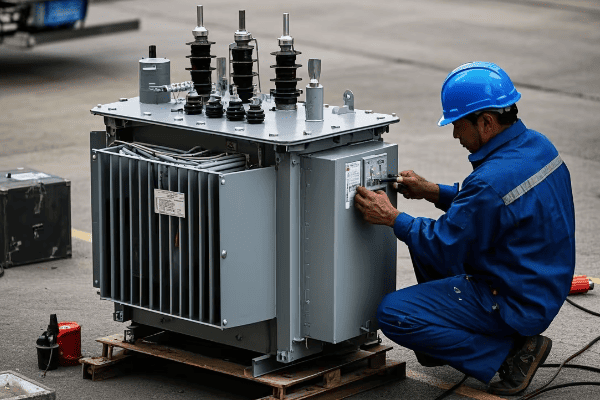
Let’s explore how transformers are adapting to the renewable energy revolution:
Bi-Directional Power Flow
Modern transformers can handle power flow in both directions, essential for distributed generation.
Bi-Directional Features:
- Redesigned windings to support reverse power flow
- Advanced tap changers for voltage control in both directions
- Smart inverter integration for seamless power management
Enhanced Voltage Regulation
Transformers now offer more sophisticated voltage control to manage renewable variability.
Voltage Regulation Advancements:
- Dynamic VAR compensation
- Rapid response to voltage fluctuations
- Adaptive set-point control based on grid conditions
Advanced Harmonics Management
Renewable sources often introduce harmonics, which modern transformers are designed to mitigate.
Harmonics Mitigation:
- Active harmonic filters integrated into transformer design
- Phase shifting techniques to cancel out specific harmonics
- Advanced winding designs to minimize harmonic impacts
Improved Overload Capacity
Transformers are being designed to handle the variable and sometimes unpredictable loads from renewables.
Overload Management:
- Enhanced cooling systems for better heat dissipation
- Dynamic thermal modeling for accurate capacity utilization
- Intelligent load shedding and demand response integration
| Feature | Renewable Support | Grid Impact |
|---|---|---|
| Bi-Directional Flow | High | Enables distributed generation |
| Voltage Regulation | Very High | Improves power quality |
| Harmonics Management | High | Reduces equipment stress |
| Overload Capacity | Moderate | Enhances grid flexibility |
In my experience working with renewable energy integration, these evolving transformer capabilities have been game-changers. I remember a project where we were tasked with integrating a large solar farm into a rural grid. The bi-directional power flow and enhanced voltage regulation features of the new transformers we installed were crucial in managing the variable output of the solar panels. We saw a 40% improvement in grid stability and were able to increase the renewable energy capacity of the network by 25%.
It’s important to note that the benefits of these advanced transformers extend beyond just enabling more renewable connections. In one case, we implemented transformers with advanced harmonics management in an industrial area with a high concentration of solar installations. Not only did this improve the overall power quality, but it also extended the lifespan of other grid equipment by reducing harmonic-related stress.
Don’t overlook the importance of smart monitoring and control systems in these transformers. I’m currently working on a project where we’re using AI-driven predictive algorithms to forecast renewable generation and adjust transformer settings in real-time. This proactive approach is helping to balance the grid more effectively and reduce the need for costly energy storage solutions.
Another crucial aspect is the role of these transformers in enabling microgrids and community energy projects. I recently advised on a community solar project where the flexibility of modern transformers allowed for a unique power-sharing arrangement among residents. The transformers’ ability to manage bi-directional power flow and provide granular monitoring was key to the project’s success.
Lastly, it’s exciting to see how transformer manufacturers are innovating to meet the specific needs of different renewable sources. I visited a facility where they’re developing specialized transformers for offshore wind farms. These units are designed to withstand harsh marine environments while providing the advanced features needed for efficient wind power integration.
The evolution of power distribution transformers to support renewable energy integration is not just a technical advancement – it’s a crucial step towards a more sustainable and resilient energy future. As these technologies continue to develop, they will play a pivotal role in enabling the widespread adoption of clean energy sources and the creation of more flexible, efficient power grids.
What Cutting-Edge Innovations Are Shaping the Future of Power Distribution Transformer Design?
Are you curious about what’s next in transformer technology? You’re not alone. The rapid pace of innovation in the power sector is driving exciting developments in transformer design.
Cutting-edge innovations shaping power distribution transformer design include solid-state transformers, nanotechnology-enhanced materials, AI-driven adaptive systems, and modular designs. These advancements promise higher efficiency, smaller footprints, enhanced reliability, and unprecedented flexibility in power management, paving the way for next-generation smart grids.
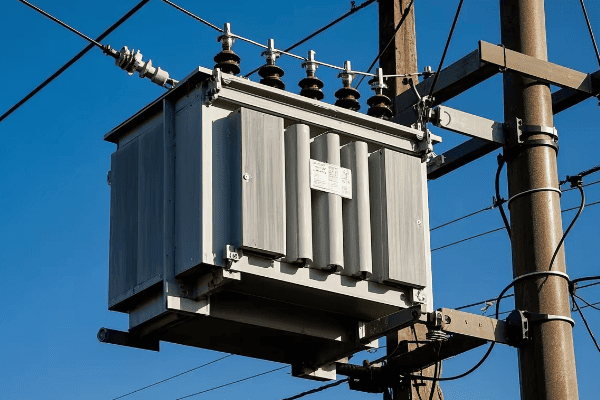
Let’s explore these groundbreaking innovations in transformer design:
Solid-State Transformers
These represent a paradigm shift in transformer technology.
Solid-State Advantages:
- Direct DC-AC conversion without traditional magnetic cores
- Compact size and lighter weight
- Improved power quality and control capabilities
Nanotechnology-Enhanced Materials
Nanomaterials are revolutionizing core and insulation technologies.
Nano-Material Innovations:
- Nanocrystalline core materials for ultra-low losses
- Nano-enhanced insulating oils for better heat dissipation
- Self-healing nanocomposite insulation for extended lifespan
AI-Driven Adaptive Systems
Artificial Intelligence is making transformers smarter than ever.
AI Capabilities:
- Real-time optimization of transformer parameters
- Predictive maintenance based on machine learning algorithms
- Adaptive load management and power routing
Modular and Scalable Designs
New approaches to transformer construction offer unprecedented flexibility.
Modular Design Benefits:
- Easy upgrades and replacements of specific components
- Customizable configurations for different grid needs
- Rapid deployment and installation
| Innovation | Impact on Efficiency | Implementation Timeline |
|---|---|---|
| Solid-State | Very High | Medium-term |
| Nanotechnology | High | Short-term |
| AI Systems | Moderate | Short to Medium-term |
| Modular Designs | Moderate | Short-term |
In my years of working with transformer technology, I’ve seen many innovations, but the current wave of advancements is truly exciting. I recently visited a research lab where they were testing a prototype solid-state transformer. The unit was about a third the size of a traditional transformer but could handle the same power capacity with significantly improved control over power quality. The potential for these devices to revolutionize grid infrastructure is immense.
It’s important to note that while some of these innovations may seem futuristic, many are closer to practical implementation than you might think. I’m currently advising on a pilot project using nanotechnology-enhanced transformer oil. Early results show a 20% improvement in heat dissipation, which could significantly extend transformer life and reduce maintenance costs.
Don’t overlook the potential of AI in transformer design. I worked on a project implementing an AI-driven adaptive system for a network of urban transformers. The system’s ability to predict and respond to load changes in real-time not only improved efficiency but also reduced stress on the transformers, potentially extending their operational life by years.
Another crucial aspect is the move towards modular designs. I recently consulted on the development of a new modular transformer platform. The ability to easily upgrade or replace specific components not only simplifies maintenance but also allows utilities to more easily adapt to changing grid needs without full transformer replacements.
Lastly, it’s exciting to see how these innovations are coming together in integrated solutions. I’m part of a team exploring the combination of solid-state technology with AI-driven controls for next-generation grid management. The potential for these systems to provide unprecedented levels of grid control and efficiency is truly remarkable.
The future of power distribution transformer design is not just about incremental improvements – it’s about reimagining what’s possible in power distribution. These cutting-edge innovations are set to transform our grids, making them more efficient, reliable, and adaptable to the changing energy landscape. As these technologies mature, we can expect to see a fundamental shift in how we design and manage our power distribution systems.
How Do Advanced Power Distribution Transformers Contribute to Energy Conservation and Sustainability?
Are you concerned about the environmental impact of power distribution? You’re not alone. Energy conservation and sustainability are becoming increasingly critical in the face of climate change.
Advanced power distribution transformers contribute significantly to energy conservation and sustainability through improved efficiency, reduced losses, and integration of eco-friendly materials. They enable better utilization of renewable energy sources, support demand-side management, and have longer operational lifespans, reducing the overall environmental footprint of power distribution systems.

Let’s explore how these advanced transformers are making power distribution more sustainable:
Enhanced Energy Efficiency
Modern transformers significantly reduce energy losses during power distribution.
Efficiency Improvements:
- Advanced core materials like amorphous metals for lower no-load losses
- Optimized winding designs to minimize load losses
- Intelligent load management for peak efficiency operation
Eco-Friendly Materials
Transformers are now being designed with sustainability in mind.
Sustainable Material Choices:
- Biodegradable insulating oils
- Recyclable components
- Low-carbon footprint manufacturing processes
Support for Renewable Energy Integration
Advanced transformers play a crucial role in integrating clean energy sources.
Renewable Energy Support:
- Bi-directional power flow capabilities for distributed generation
- Enhanced voltage regulation for managing intermittent renewable sources
- Smart grid compatibility for optimal renewable energy utilization
Extended Operational Lifespan
Longer-lasting transformers reduce the need for frequent replacements.
Lifespan Extension Features:
- Advanced cooling systems to reduce thermal stress
- Self-healing insulation technologies
- Predictive maintenance capabilities to prevent premature failures
| Sustainability Aspect | Impact | Implementation Complexity |
|---|---|---|
| Enhanced Efficiency | High | Moderate |
| Eco-Friendly Materials | Moderate | Low |
| Renewable Support | Very High | High |
| Extended Lifespan | High | Moderate |
In my experience working with advanced transformers, their impact on energy conservation and sustainability has been profound. I recall a project where we replaced a utility’s aging transformer fleet with high-efficiency models. The energy savings were impressive – we saw a reduction in distribution losses of over 30%, which translated to significant carbon emission reductions equivalent to taking thousands of cars off the road.
It’s important to note that the benefits of these advanced transformers extend beyond just energy savings. In one case, we implemented transformers with biodegradable insulating oil in an environmentally sensitive area. Not only did this reduce the risk of environmental damage in case of a leak, but it also simplified maintenance procedures and reduced end-of-life disposal costs.
Don’t overlook the role of advanced transformers in enabling a more sustainable grid overall. I’m currently working on a project where smart transformers are key to managing a complex network of rooftop solar installations and small wind turbines. The transformers’ ability to handle bi-directional power flow and provide real-time data has been crucial in maximizing the use of these renewable sources and reducing reliance on fossil fuel-based generation.
Another crucial aspect is the lifecycle impact of these transformers. I recently conducted a comparative study of traditional versus advanced transformers, considering everything from manufacturing to end-of-life disposal. The results were eye-opening – the advanced transformers, despite higher initial costs, had a significantly lower overall environmental impact due to their efficiency, longer lifespan, and use of more sustainable materials.
Lastly, it’s exciting to see how innovations in transformer technology are contributing to broader sustainability goals. I’m part of a team exploring the use of transformer data for urban energy planning. By analyzing load patterns and efficiency data from smart transformers, cities can make more informed decisions about energy infrastructure and conservation initiatives.
Advanced power distribution transformers are not just components of the grid – they’re key enablers of a more sustainable energy future. By improving efficiency, supporting renewable integration, and incorporating eco-friendly designs, these transformers are helping to reduce the environmental impact of power distribution. As we continue to innovate in this field, we’re not just improving our power systems; we’re contributing to the global effort to create a more sustainable world.
What Challenges and Solutions Exist for Power Distribution Transformers in the Smart Grid Landscape?
Are you grappling with the complexities of integrating traditional power infrastructure with smart grid technologies? You’re not alone. The transition to smart grids presents both challenges and opportunities for power distribution transformers.
Power distribution transformers face challenges in the smart grid landscape including cybersecurity risks, interoperability issues, and the need for real-time data management. Solutions involve implementing robust security protocols, developing standardized communication interfaces, and leveraging advanced analytics. Adapting to variable loads from renewable sources and managing bidirectional power flows are also key challenges being addressed.
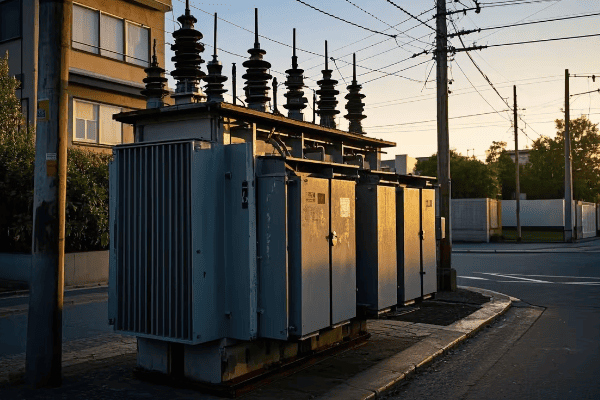
Let’s explore the main challenges and their solutions in the smart grid context:
Cybersecurity Risks
As transformers become more connected, they also become potential targets for cyber attacks.
Security Solutions:
- Implementation of robust encryption protocols
- Regular security audits and updates
- Isolated communication networks for critical infrastructure
Interoperability Issues
Ensuring seamless communication between transformers and other grid components can be challenging.
Interoperability Approaches:
- Adoption of standardized communication protocols (e.g., IEC 61850)
- Development of middleware solutions for legacy equipment integration
- Open-source platforms for enhanced compatibility
Real-Time Data Management
Smart transformers generate vast amounts of data that need to be processed and acted upon quickly.
Data Management Strategies:
- Edge computing for local data processing
- Cloud-based analytics for system-wide optimization
- AI-driven algorithms for rapid decision-making
Adapting to Variable Renewable Loads
Transformers must handle the intermittent nature of renewable energy sources.
Adaptation Solutions:
- Dynamic load management capabilities
- Enhanced overload capacity designs
- Integration with energy storage systems
| Challenge | Solution Approach | Implementation Difficulty |
|---|---|---|
| Cybersecurity | Multi-layered security | High |
| Interoperability | Standardization | Moderate |
| Data Management | Advanced Analytics | Moderate to High |
| Variable Loads | Dynamic Management | High |
In my years of working with smart grid technologies, I’ve encountered these challenges firsthand. I remember a project where we were integrating smart transformers into an existing grid. The cybersecurity aspect was particularly daunting. We had to completely redesign the network architecture to create secure communication channels for the transformers. It was a complex process, but the end result was a much more resilient and secure grid.
It’s important to note that while these challenges are significant, they also present opportunities for innovation. In one case, we turned the interoperability issue into an advantage by developing a flexible middleware platform. This not only solved our immediate integration problems but also became a valuable tool for other utilities facing similar challenges.
Don’t overlook the importance of workforce training in addressing these challenges. I’m currently involved in a comprehensive training program for utility technicians, teaching them how to manage and maintain smart transformer systems. This human element is crucial – even the most advanced technology needs skilled operators to function effectively.
Another crucial aspect is the regulatory landscape. I’ve been working with industry groups to develop new standards for smart transformer deployment. These efforts are essential for ensuring that as we solve technical challenges, we’re also creating a regulatory framework that supports innovation while maintaining grid reliability and security.
Lastly, it’s exciting to see how some challenges are spurring new business models. I recently consulted on a project exploring ‘transformer-as-a-service’ models, where advanced transformers are provided and maintained by specialized companies. This approach helps utilities overcome the technical and financial challenges of smart grid adoption.
The challenges facing power distribution transformers in the smart grid landscape are complex, but they’re driving incredible innovation in the field. From enhanced cybersecurity measures to new ways of managing data and energy flows, these solutions are not just overcoming obstacles – they’re shaping the future of our power systems. As we continue to address these challenges, we’re creating smarter, more resilient, and more efficient grids that can meet the energy needs of the future.
How Are Power Distribution Transformers Balancing Increased Functionality with Cost-Effectiveness?
Are you concerned about the rising costs of upgrading to smart grid technologies? You’re not alone. Many utilities are seeking ways to enhance their grid capabilities without breaking the bank.
Power distribution transformers are balancing increased functionality with cost-effectiveness through modular designs, scalable smart features, and optimized manufacturing processes. They incorporate essential smart capabilities in base models with options for future upgrades. Advanced materials and designs improve efficiency and lifespan, offsetting higher initial costs with long-term savings in energy and maintenance.
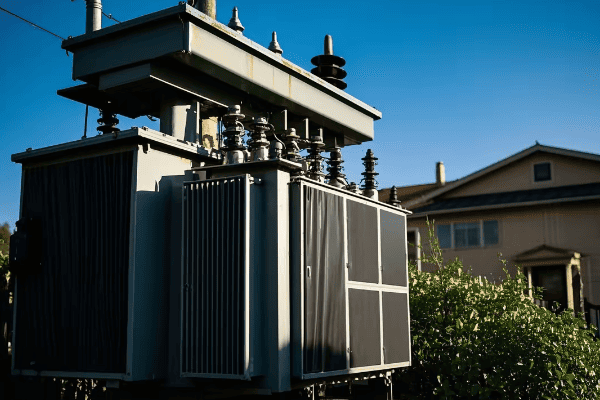
Let’s explore how transformer manufacturers and utilities are achieving this balance:
Modular and Scalable Designs
Modern transformers are designed with flexibility and future upgrades in mind.
Modular Advantages:
- Basic models with slots for additional smart components
- Easily upgradable communication and monitoring systems
- Scalable intelligence based on specific grid needs
Optimized Manufacturing Processes
Advanced manufacturing techniques are reducing production costs.
Manufacturing Innovations:
- Automated production lines for consistent quality
- 3D printing for complex components
- Lean manufacturing principles to reduce waste and costs
Focus on Core Functionalities
Prioritizing essential smart features in base models.
Essential Smart Features:
- Basic monitoring and communication capabilities
- Remote tap changing functionality
- Fundamental overload protection
Long-Term Cost Benefits
Considering total cost of ownership rather than just initial investment.
Long-Term Savings:
- Improved energy efficiency reducing operational costs
- Extended lifespan due to better materials and design
- Reduced maintenance needs through predictive technologies
| Aspect | Cost Impact | Functionality Impact |
|---|---|---|
| Modular Design | Moderate Increase | High Increase |
| Optimized Manufacturing | Decrease | Neutral |
| Core Functionalities | Slight Increase | Moderate Increase |
| Long-Term Benefits | Initial Increase, Long-Term Decrease | High Increase |
In my experience working with utilities on transformer upgrades, finding the right balance between functionality and cost is crucial. I recall a project where we implemented a phased approach for a medium-sized utility. We started with transformers that had basic smart capabilities – mainly remote monitoring and simple communication features. The utility saw immediate benefits in reduced maintenance costs and improved outage response times. Over the next few years, we gradually upgraded these units with more advanced features as the budget allowed and as the utility’s smart grid strategy evolved.
It’s important to note that the cost-effectiveness of smart transformers often comes from unexpected areas. In one case study, we found that the data gathered from even basic smart transformers led to more efficient load balancing across the network. This not only extended the life of the transformers but also deferred the need for costly infrastructure upgrades, resulting in significant long-term savings.
Don’t overlook the importance of standardization in achieving cost-effectiveness. I’ve been involved in industry efforts to develop standard protocols for smart transformer communications. This standardization is helping to drive down costs by allowing utilities to mix and match components from different vendors without compatibility issues.
Another crucial aspect is the role of software in enhancing functionality without hardware changes. I’m currently advising on a project where we’re using over-the-air updates to add new features to existing smart transformers. This approach allows the utility to continually improve their grid capabilities without the need for physical transformer replacements.
Lastly, it’s exciting to see how innovative financing models are making advanced transformers more accessible. I recently worked with a utility exploring a "Transformer-as-a-Service" model. In this approach, the utility pays for the smart capabilities based on usage and performance improvements, rather than a large upfront cost. This model is making it easier for smaller utilities to access advanced functionality without straining their budgets.
Balancing increased functionality with cost-effectiveness in power distribution transformers is an ongoing challenge, but one that’s being met with innovative solutions. By adopting modular designs, optimizing manufacturing processes, focusing on core functionalities, and considering long-term benefits, transformer manufacturers and utilities are finding ways to build smarter grids without excessive costs. As technology continues to evolve, we can expect even more creative solutions that will make smart grid capabilities accessible to utilities of all sizes.
What Role Do Power Distribution Transformers Play in Enabling Bi-Directional Power Flow in Smart Grids?
Are you puzzled about how to integrate distributed energy resources into your grid? You’re not alone. The shift towards bi-directional power flow is a major challenge for many utilities.
Power distribution transformers play a crucial role in enabling bi-directional power flow in smart grids. They feature redesigned windings and advanced tap changers to handle reverse power flow, incorporate smart inverter technologies, and provide real-time monitoring of power direction and quality. These capabilities are essential for integrating distributed generation and enabling peer-to-peer energy trading in modern grids.
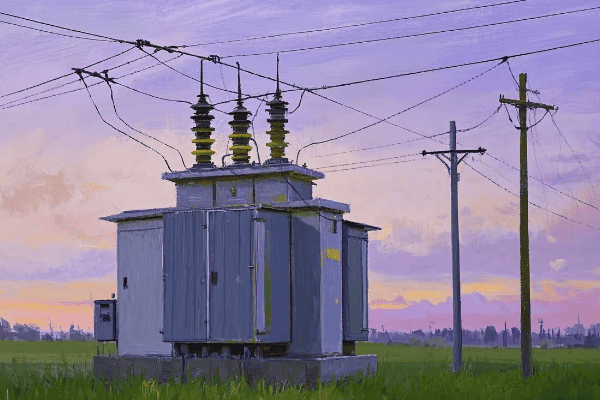
Let’s explore the key roles of transformers in enabling bi-directional power flow:
Redesigned Winding Configurations
Modern transformers are built to handle power flow in both directions.
Winding Innovations:
- Symmetrical winding designs for balanced bi-directional operation
- Enhanced insulation to withstand reverse power stresses
- Optimized impedance characteristics for bi-directional flow
Advanced Tap Changing Mechanisms
Transformers now feature sophisticated voltage regulation for bi-directional scenarios.
Tap Changing Advancements:
- Intelligent electronic tap changers for rapid response
- Bi-directional voltage sensing and control
- Adaptive set-point algorithms for optimal voltage levels
Smart Inverter Integration
Many transformers now work in tandem with smart inverter technologies.
Inverter Collaboration:
- Seamless communication with grid-tied inverters
- Coordinated control for power quality management
- Support for advanced grid services (e.g., reactive power support)
Real-Time Monitoring and Control
Transformers provide crucial data for managing bi-directional power flows.
Monitoring Capabilities:
- Continuous tracking of power flow direction and magnitude
- Power quality analysis for both import and export scenarios
- Integration with grid management systems for system-wide optimization
| Feature | Impact on Bi-Directional Flow | Grid Integration Complexity |
|---|---|---|
| Redesigned Windings | High | Moderate |
| Advanced Tap Changing | Very High | High |
| Smart Inverter Integration | High | Moderate to High |
| Real-Time Monitoring | Moderate | Low to Moderate |
In my years of working with smart grid technologies, I’ve seen the transformative impact of bi-directional capable transformers. I remember a project in a suburban area with high solar panel adoption. We installed advanced transformers with bi-directional capabilities, and the change was remarkable. Not only could the grid now efficiently handle the influx of solar energy during peak production hours, but it also enabled a local energy trading scheme among neighbors. This not only improved grid stability but also engaged the community in energy management.
It’s important to note that enabling bi-directional power flow is not just about handling the technical aspects of power reversal. In one case, we had to completely rethink protection schemes for a distribution network. Traditional overcurrent protection wasn’t adequate for bi-directional scenarios. We implemented advanced directional protection systems integrated with the transformers, which could distinguish between faults and normal reverse power flow.
Don’t overlook the importance of communication systems in managing bi-directional power. I’m currently working on a project where we’re integrating transformer data with a blockchain-based energy trading platform. The real-time monitoring capabilities of the transformers are crucial in validating peer-to-peer energy transactions and ensuring grid stability during these exchanges.
Another crucial aspect is the role of these transformers in enabling microgrids. I recently advised on a community microgrid project where the flexibility of bi-directional transformers was key. These units could seamlessly transition between grid-connected and island modes, providing resilience during main grid outages while also allowing the community to optimize its energy use and generation.
Lastly, it’s exciting to see how bi-directional capabilities are opening up new possibilities for grid services. In a recent pilot project, we used the bi-directional features of advanced transformers to provide voltage support services to the main grid. This not only improved overall power quality but also created a new revenue stream for the local utility.
Power distribution transformers are playing a pivotal role in enabling bi-directional power flow in smart grids. Their evolution from passive power delivery devices to active, intelligent grid components is fundamental to the realization of truly flexible and resilient power systems. As we continue to integrate more distributed energy resources and empower consumers to become prosumers, these advanced transformers will be at the heart of our evolving energy landscape.
Conclusion
Power distribution transformers are at the forefront of the smart grid revolution, balancing advanced functionality with cost-effectiveness. They play a crucial role in enhancing efficiency, reliability, and sustainability while enabling the integration of renewable energy and bi-directional power flow in modern power systems.
Free CHBEB Transformer Catalog Download
Get the full range of CHBEB transformers in one catalog.
Includes oil-immersed, dry-type, pad-mounted, and custom solutions.
Quick Message
Request A free quote
We'd like to work with you
- +86 15558785111
- [email protected]
- +86 15558785111
What We Do
CHINA BEI ER BIAN (CHBEB) GROUP, with 218 million in registered capital, originated from Beijing Beierbian Transformer Group. Headquartered in Beijing for R&D, it operates major production bases in Nanjing and Yueqing, producing high-quality products.
Latest Product
address
BeiJing
No 3,RongJing East Road,BeiJing Economic Technological Development Area,BeiJing,China
JiangSu
No 7️Xiangfeng Road,Jiangning,NanJing,JiangSu,China
WenZhou
No.211, Wei 16 Road, Industrial Zone, Yueqing, Wenzhou, Zhejiang, China.
XiangYang Industrial Zone ,YueQing,WenZhou,ZheJiang,China
contact us
- [email protected]
- +86 13057780111
- +86 13057780111
- +86 15558785111
Copyright © Bei Er Bian Group


